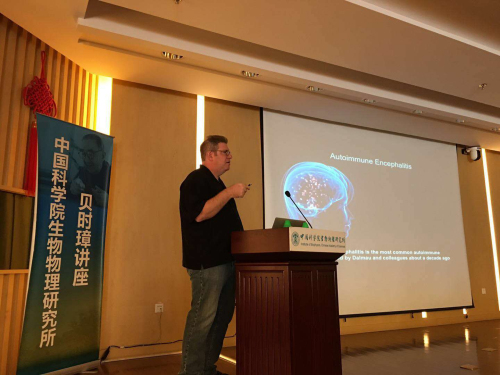Dr. Samuel J. Pleasure from UCSF Visited IBP and Delivered a BEI Shizhang Lecture
On October 11, 2017, Dr. Samuel J. Pleasure from the University of California, San Francisco (UCSF), invited by Prof. Xiaoqun Wang, visited IBP and gave a BEI Shizhang lecture entitled the role of NMDA receptors in the development of callosal projection and circuits.
Dr. Pleasure obtained his MD in medicine and PhD in neuroscience at the University of Pennsylvania in 1993. He was chief resident during his neurology residency at UCSF, where he then completed a research fellowship in neuroscience. Dr. Pleasure is a fellow of the American Neurological Association and a member of the American Academy of Neurology, American Epilepsy Society, Society for Neuroscience, Society for Developmental Biology and Cajal Club. He has won numerous awards for his research and has received funding from a wide variety of private, state and federal sources. He has served in leadership roles in national organizations and in the UCSF Department of Neurology.
Dr. Pleasure's research focuses on two main areas of inquiry. He studies processes that regulate early brain development, which is important for the formation and organization of the cerebral cortex in both normal and diseased situations. He also studies autoimmune forms of meningoencephalitis, which is inflammation in specific brain areas causing severe neurologic dysfunction.
On the lecture, Dr. Pleasure focused on the work in the pathogenesis of NMDA receptor-induced autoimmune encephalitis. He introduced the epidemiology of encephalitis in the children and adolescent, as well as the young adults. Based on the clinic case flow,the Pleasure group highlighted the genetic mechanism that resulted in the encephalitis. One of the NMDA receptor subunits, NR1 was found contributing to the homotopic projection between the two hemisphere somatosensory cortex via corpus callosum. Utilizing the method of utero electroporation, the callosal axon was labeled via EGFP, for helping mapping the developmental pattern in the somatosensory cortex. They found the pattern was abnormal in the NR1-KO mouse brain, where the homotopic projection was more dispersed. Further more, NR1 antibody injection increased the ectopic callosal projection during the maturation, compared to the normal situation. The ongoing work will uncover the detailed mechanism by using this model of antibody trigged encephalitis. This might provide a new clue for autoimmune encephalitis diagnosis.
After the presentation, students and scientists discussed with Dr. Pleasure. Dr. Pleasure also had a further discussion with Professor Xiaoqun Wang’s team and graduate students from IBP.


